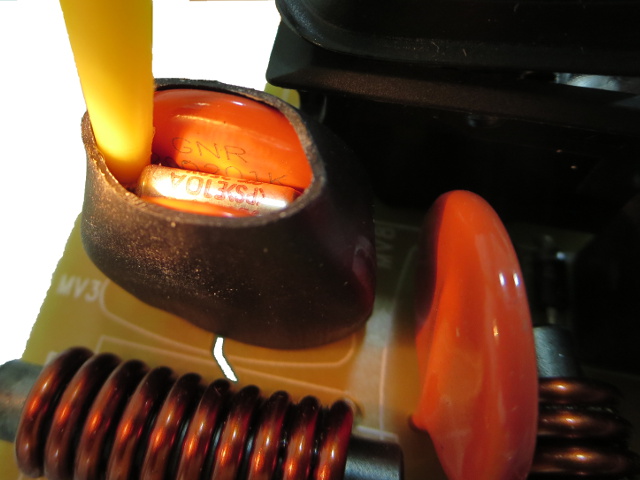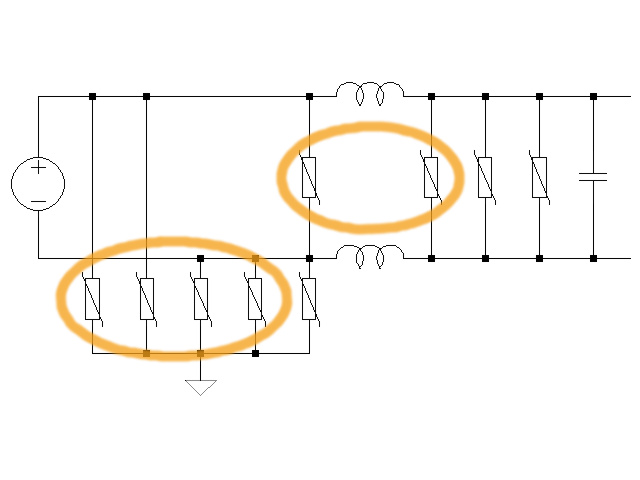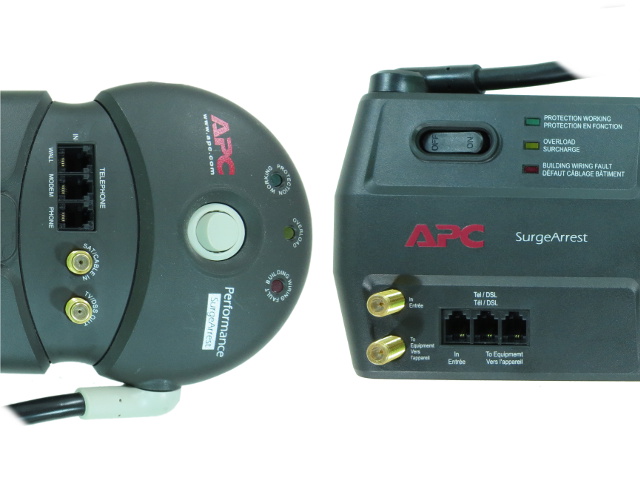APC's Current-Gen SurgeArrest: A Modern Tear-Down
After our first tear-down, APC wanted to send in a modern equivalent to demonstrate the company's dedication to quality. Follow along as we tear open another power strip and dig deep into its electrical composition.
Metal Oxide Voyeurism
Remember a few slides ago when I was wondering why the new model's protection had higher transient voltage ratings? Prying shrink-wrapped MOVs revealed those I could read this way to be GNR 20D201K, just like the old models, which were rated at 330V. Looks like the changes are simply a tweak in how they calculate and report ratings rather than component swaps.
MOV Ratings On The Line
Metal Oxide Varistors typically have four different voltage ratings:
- the nominal operating voltage below which the MOV does nothing
- the varistor voltage at which the MOV current reaches 1mADC – this is the rating that ends up in the model number: the 201 in 20D201K stands for 20x101 volts or about 200V
- the clamping voltage when the MOV is conducting its nominal rated current and repeatable pulse energy which the MOV is expected to be able to survive thousands of times if given a chance to cool down between pulses
- sometimes, the surge voltage when conducting its absolute maximum surge current which the MOV should be able to clamp but might not survive
In the GNR 20D201K's case, those would be 170VDC, 205V, 340V at 100A and 140 joules per pulse, and unspecified surge voltage at either 10kA one-shot or 6.5kA two-shots, respectively. This means connected equipment should not actually see much more than 340V unless the surge currents exceed 100A per MOV. Perhaps a schematic would make that easier to see.
The MOV Connection
If you had trouble imagining how those MOVs fit together based on my description over the last few slides, here is a simplified picture of what I meant. Orange circles highlight 20D201K MOVs sharing a thermal shut-off and the remaining two devices are unprotected 20D471K. The top two MOVs correspond to the pair shrink-tubed to the live-side thermal fuse, while the bottom four correspond to the two other heat-shrunk MOV pairs and their respective thermal shut-off. Crossing connections on the main MOVs lets them leverage the inductors to dampen transients and reduce the burden on individual devices.
Since the MOVs have a combined nominal rating of about 1.5kJ, other design considerations must be behind the packaging's 3kJ claim. Those likely include losses in the power cord, voltage drop across the inductors and “over-driving” the MOVs at the expense of potentially shorter lifespan. Since APC offers a lifetime warranty, the company is obviously not expecting many failures from this.
MOV Improvements
For comparison's sake, here is the simplified schematic of the old design. As you can see, six out of the old model's nine MOVs are located directly across mains lines where they have to eat the brunt of mains-side transients with no help from inductors to soften the blows.
The new design may have one less MOV than the old design, but they are being used in a more refined manner, which should enhance their effectiveness.
Get Tom's Hardware's best news and in-depth reviews, straight to your inbox.
Less Is More
While the two models have nearly identical parts lists, a more clever use of MOVs in the new SurgeArrest should give it an advantage for surge protection. The millimeter-wide traces still bother me, though.
Aside from the loss of switched outlets and perhaps a regression in terms of aesthetics, I would have to call the new model a winner in terms of functionality. Its much less accident-prone switch is quite welcome, and the sliding outlet shutters are also less troublesome to deal with when you do not really need or want them. The boxier and flatter design is also less likely to cause fitting issues, and the more industrial look may appeal to fans of function over form.
-
errdizzy I still don't touch APC products anymore. I used to have all TVs, computers and game systems in my house connected to them. It only took a year for the batteries in all of them to die (at different times). I switched the another manufacturer and haven't had a problem since. Going on 2 years now...Reply -
jll544 "Surprisingly, the new unit has higher surge suppression voltage ratings than the old unit"Reply
Actually, not surprising because it's not valid to compare the ratings between the different generations. The old surge protector was rated under UL 1449 2nd Edition, whereas the new one was rated under UL 1449 3rd Edition. The 3rd Edition test applies a much higher current, so the higher voltage is expected. -
SWB02 APC sent you this unit? If so, then knowing it would be subjected to a public teardown and critique, I expect they will have thoroughly inspected it beforehand to ensure it was a shining example of their absolute best workmanship.Reply
Much more interesting would be a teardown of a unit obtained independently through normal retail channels. -
Peter Martin Tripp Lite power surge suppressors for me. ONLY. I would never use anything else.Reply -
Daniel Sauvageau Reply
I wanted to take a look at that but could not find a free copy of it online; only various companies' notes highlighting differences relevant to their respective business. Without access to the original document, I have no idea how comprehensive and accurate those whitepapers's change lists are.14340106 said:Actually, not surprising because it's not valid to compare the ratings between the different generations. The old surge protector was rated under UL 1449 2nd Edition, whereas the new one was rated under UL 1449 3rd Edition. The 3rd Edition test applies a much higher current, so the higher voltage is expected.
For example, GE's version does describe the new test conditions (6kV at up to 500A for 2nd vs 6kV input at up to 3kA for 3rd) but it is preceded by a mention that only type-1 and type-2 SPDs (meter/panel-mount) will be further discussed, which seemed to imply that the above was specific to those types. -
Daniel Sauvageau Reply
They most likely did at least check it out for any obvious issues but then again, the new design has fewer wires attaching to the PCB and none of them directly to the traces from the copper side, which should considerably reduce the potential for handling mistakes.14340759 said:APC sent you this unit? If so, then knowing it would be subjected to a public teardown and critique, I expect they will have thoroughly inspected it beforehand to ensure it was a shining example of their absolute best workmanship. -
merikafyeah Sacrificial surge suppressors are all well and good when you're on a budget, but they still don't hold a candle to non-sacrificial surge suppressors like those from Brickwall and SurgeX. All things considered, the cheaper Brickwall units are actually not THAT much more expensive than the most expensive sacrificial surge suppressors, and they are well worth every penny, especially considering you never need to replace them.Reply
I recommend this unit in particular for its value/$:
http://www.brickwall.com/collections/surge-protectors-home-theater-hdtv/products/eight-outlet-audio-surge-protector
Made in USA, not China like almost every other surge suppressor you can buy today. You get what you pay for, and I learned the hard way with cheap suppressors. -
JackNaylorPE Reply14339730 said:I still don't touch APC products anymore. I used to have all TVs, computers and game systems in my house connected to them. It only took a year for the batteries in all of them to die (at different times). I switched the another manufacturer and haven't had a problem since. Going on 2 years now...
Agreed .... same here .... and replacing the batteries is not done because it's cheaper to buy a new unit. Since The Schneider take over, it's not the same company and certainly not the same product we used to see.
-
Daniel Sauvageau Reply
Do you happen to have an appnote or something that details how Brickwall/SurgeX's "non-sacrificial" surge protection works? Both companies have the exact same diagram that does not give any useful details about it.14341382 said:Sacrificial surge suppressors are all well and good when you're on a budget, but they still don't hold a candle to non-sacrificial surge suppressors like those from Brickwall and SurgeX.
Everything I can find about anything resembling that from other vendors effectively boils down to slapping an LC filter in front of the MOVs to block or dampen most of the high-frequency, high-energy stuff so the MOVs do not need to deal with (as much of) it.




